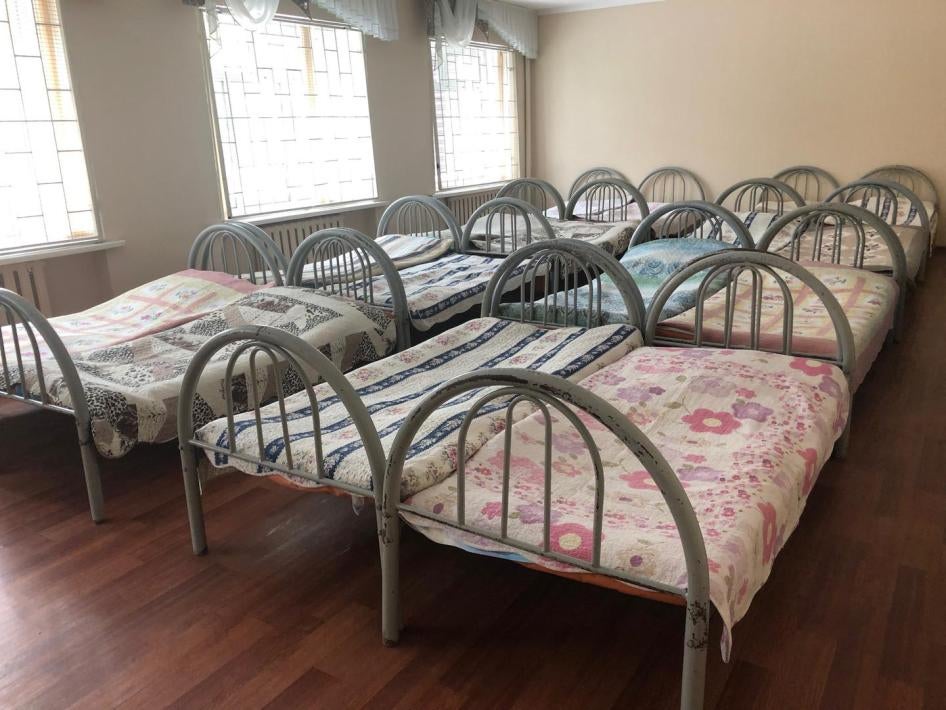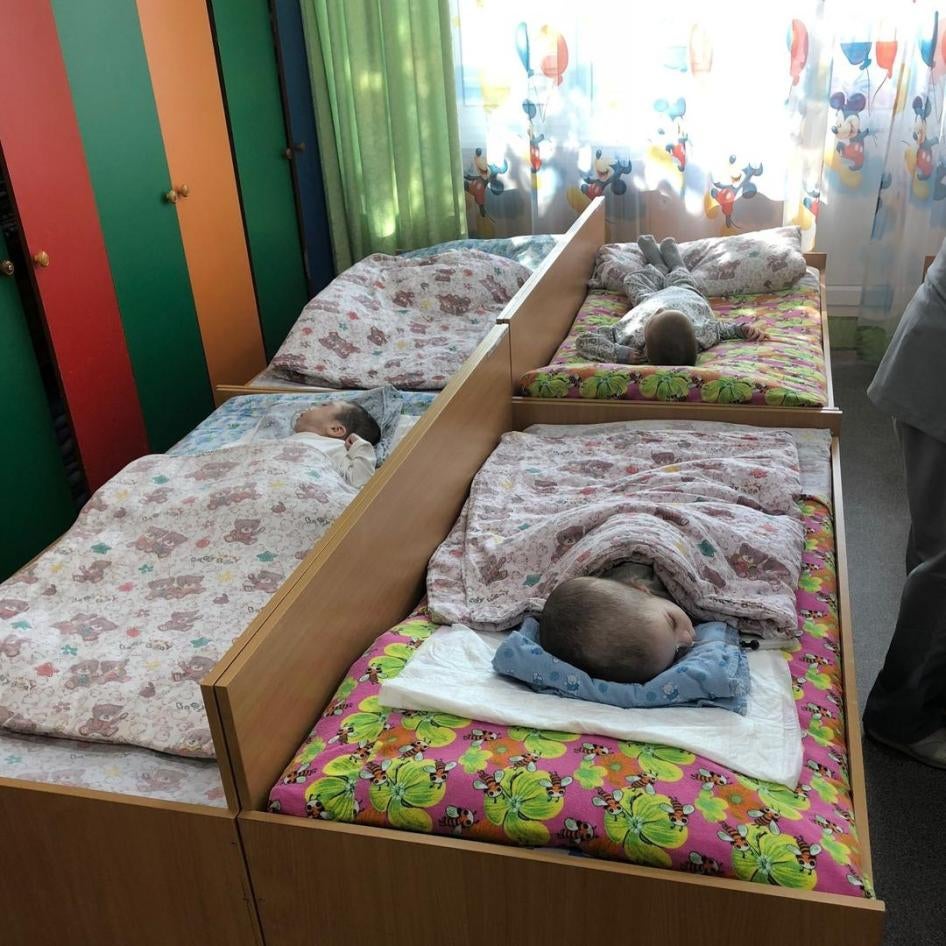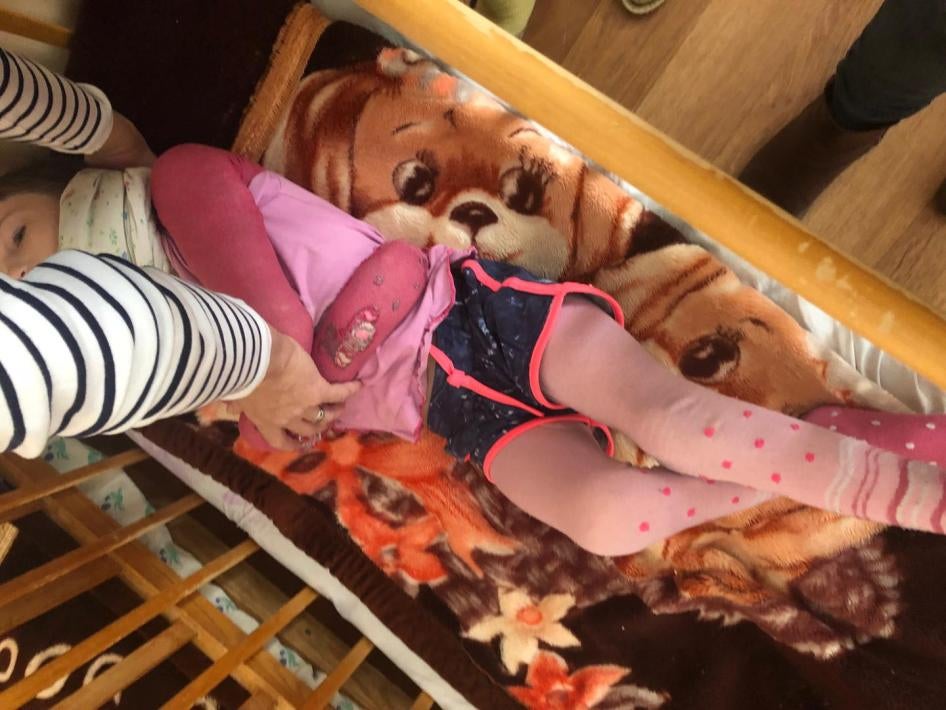(Berlin) – Children with disabilities in state institutions in Kazakhstan are at risk of physical violence, forced sedation, and neglect, Human Rights Watch said today.
Kazakhstan should make it a priority to move children with disabilities out of closed residential institutions and provide support for children with disabilities to live with their families, or in other family settings in the community. All forms of violence in closed institutions and the use of restraints as a form of punishment, control, or retaliation, or as a measure of convenience for staff, should be prohibited.
“Hundreds of children and young adults with disabilities in Kazakhstan are locked away in closed children’s institutions, where they can face neglect and violence, and are isolated from families and society,” said Mihra Rittmann, senior Central Asia researcher at Human Rights Watch. “Kazakhstan should call a halt to these abusive practices and urgently develop a way for children with disabilities and their families to get the services they need to protect their right to a family life.”
Between October 2017 and April 2019, Human Rights Watch interviewed 27 children and young adults with disabilities who had lived in closed children’s institutions, as well as parents of children with disabilities, institution staff, and disability rights experts and activists. Human Rights Watch also visited three institutions for children with disabilities.
Children and young adults who grew up in closed institutions for children with disabilities reported that staff beat them, forcibly administered sedatives to punish or control them, and forced them to take care of younger children.
According to the Ministry of Labor and Social Protection, Kazakhstan has 19 state institutions for children with mental health conditions and developmental disabilities. More than 2,000 children live in these institutions, though many have at least one living parent.
Staff confirmed that they use psychotropic drugs to sedate children and have sent children to psychiatric hospitals for behavior such as screaming, shouting, or refusing to follow staff directions. Such drugs are usually medically prescribed to treat schizophrenia, sleep disorders, and strong pain. The sedatives put children to sleep, in some cases for up to 24 hours.
Several young adults who grew up in institutions said that staff beat them with objects such as crutches and mops, or slammed them or other children against the wall. Staff would also force children to work, for example to mop floors, or to feed, bathe, and change the diapers of younger children. In one institution, Human Rights Watch saw a young girl in physical restraints, with her arms fixed around her torso, enclosed in a pink cloth with sleeves tied behind her back, like a strait jacket.
Upon turning 18, many young adults with disabilities are automatically transferred to adult institutions and remain there. In part, this is due to a lack of services to support young adults with disabilities to live independently.
They may face more violence in the adult institutions. One man described being repeatedly stripped naked and placed in a very cold cage-like isolation room as punishment.
Children with disabilities living in state children’s institutions receive little or no education. “We don’t have a school [education] program, but a correctional program,” one institution director said. “Children here are weak and difficult.”
In all the children’s institutions Human Rights Watch visited, children face neglect. Up to 16 children are kept in rooms together, with only a few caregivers. Some children, typically those who cannot walk or talk, are confined almost continuously to cribs or beds.
After her September 2017 visit to Kazakhstan, the United Nations special rapporteur on the rights of persons with disabilities, Catalina Devandas, noted that, “Living independently in the community is one of the major challenges for persons with disabilities in Kazakhstan,” and that she had received “worrisome allegations of violence, abuse and degrading treatment against persons placed in those institutions, especially girls and women with disabilities.”
An 18-year-old man who grew up in institutions said, “It’s not a life. They fed us, dressed us. I want to build my own life. I want a life! I want to live on my own, make [my own] food, go to work.”
In correspondence with Human Rights Watch, the Labor and Social Protection Ministry acknowledged that “large dormitory-like institutions lead to overcrowding… reduce the quality of services and the social adaptation of people in society, [and] lead to the loss of family ties.” The Labor and Social Protection Ministry also said that 727 children with disabilities had been returned to their families in 2018, facilitated by the development of day care centers. The ministry said that it plans to develop smaller homes, for 10 to 50 people.
However, while such homes may be smaller in scale, they would only perpetuate institutionalization in so far as residents would not have autonomy over their daily lives. Instead, the Kazakh government should invest in the development of community-based services to support independent living for people with disabilities. If small-group living arrangements are developed, they should be community-based, voluntary, ensure autonomy and individual decision-making, with support as necessary, and include programs to teach skills for living independently.
Kazakh law states that “every child has the right to live and be raised in their family, the right to know their parents, the right to their care, and the right to live with them, except when it is contrary to their interests.” As a party to the Convention on the Rights of Persons with Disabilities, Kazakhstan should ensure that all children with disabilities can grow up in a family and be included in the community, regardless of their disability or multiple disabilities. The government is also obligated to protect children from abuse and ill-treatment and should prohibit using sedatives and physical restraints to control or punish people with disabilities.
Children should only be placed in residential institutions under the supervision of an independent judicial body, in cases of emergency, or to prevent the separation of siblings, and for a limited duration. Family reunification or placement in family-based alternative care should be the ultimate plan for the child, Human Rights Watch said.
The Kazakh government should adopt a time-bound plan to phase out the use of residential institutions for children with disabilities and prioritize accessible community-based services and support to families. The government should end abuses in closed children’s institutions and ensure rigorous monitoring of institutions pending their closure.
“All children, including those with disabilities, should be at home, with their families,” Rittmann said. “The Kazakh government should make sure that children with disabilities and their families have the support they need to live in the community, just like everyone else.”
For more information about conditions in closed institutions for children with disabilities in Kazakhstan, please see below.
Kazakhstan’s Labor and Social Protection Ministry helped facilitate access to three closed children’s institutions, in Almaty, Karaganda, and Shymkent, which Human Rights Watch visited in November and December 2018. The ministry also responded in July to a letter about conditions in such institutions. Interviews were voluntary and held in private. Human Rights Watch used pseudonyms for all the children and young adults interviewed to protect their privacy and confidentiality.
Institutionalization of Children with Disabilities
Children with disabilities in state care in Kazakhstan live in institutions known as Special Social Services Centers for Children. There are currently 19 special children’s centers, with a total of over 2,000 children. Most children in these centers have intellectual, psychosocial – that is, mental health – or developmental disabilities. They include children with Down syndrome, autism, cerebral palsy, and epilepsy. Children in Kazakhstan with other types of disabilities, such as physical or sensory disabilities, may live in residential special schools, or at home with their families, or in two specialized residential institutions for children with physical disabilities.
The practice of institutionalization in Kazakhstan carries over from its Soviet past, where, according to UNICEF, the United Nations Children’s Fund, institutions were “considered as the best public care solution” and the prevailing view was that “all those who, for different reasons, could not fit within the rules of society should be isolated.”
At the time of Human Rights Watch’s visits to special children’s centers in 2018, there were 131 children in the Almaty special children’s center; 176 children at the Shymkent special children’s center; and 175 children in Karaganda special children’s center, ages 3 to 18. The Karaganda center also has 68 young adults ages 18 and older.
While many institutionalized children have at least one living parent, parents are required by law to relinquish their parental rights to admit their children in state residential institutions. The institution director becomes the child’s legal guardian.
Treatment and Conditions
Sedatives, Forced Psychiatric Hospitalization for Control and Punishment
Several of the current or former special children’s center residents interviewed said that staff had given them sedatives, or they had seen staff give other children sedatives to control them or punish them for their behavior. Some children said that staff forced them to go to local psychiatric hospitals for behavior such as not following staff directions, which they took to be punishment. Some were forced to remain there for weeks, a month, or more.
Institution staff, as well as one parent whose child currently lives at an institution, corroborated these practices. One staff member said that a child was hospitalized after behavior such as pulling another caregiver’s hair.
Kazakh law gives psychiatrists the authority to order forced hospitalization, including for children, for monitoring or treatment. But it is not clear what, if any, basis in law exists for holding children in psychiatric hospitals for these extended periods.
The use of medications for staff convenience, to control behavior, or as punishment, is known as chemical restraint and is never acceptable. The UN special rapporteur on torture has stated that “any restraint on persons with disabilities for even a short period of time may constitute torture and ill-treatment.” Medications should only be used for therapeutic purposes and consistent with the right to the highest attainable standard of health.
Bakhyt, a 24-year-old woman who grew up in a special children’s center, said that institution staff punish children by “giving shots to make [us] sleep.” She also said that institution staff had punished her for running around in the bedroom by giving her an injection, and had sent her to the psychiatric hospital for two months. Bakhyt said that institution staff had told the attending psychiatrist that she had tried to jump out of the window, though she said she hadn’t. “They shouldn’t lie like that,” she said. “God is watching.”
Asel, 22, who grew up in the same institution, also said that staff punished children by giving them sedatives. “When they give you a shot,” she said, “then you sleep for one whole day.” Several other young people who had lived in other institutions said they too slept for long periods after staff gave them injections or pills.
Galym, now 23, was also institutionalized as a child. He said that in the special children’s center where he lived, “if you run off to go to the shop, they send you to the psychiatric hospital.” He said he was given shots twice a day which made him “slow.” He said both he and some of his caregivers asked the medical workers to stop the medication, but they refused.
Staff at all three children’s institutions said that when children become overexcited or uncontrollable, for example when they do not follow directions, the staff first summon the institution’s psychologist to talk to the child, to try and calm them. But they admitted that when that approach was not effective, they could call the doctor to give children sedatives and in more serious cases, send them to psychiatric hospitals.
One institution director said that if children “are uncontrollable, we call an ambulance, and they take the child to the psychiatric health center [hospital].” A caregiver who works with 15- to 18-year-old boys at the same institution said that staff sometimes threaten to call the psychiatric hospital ambulance to compel the boys to follow instructions. She said that staff summoned the psychiatric hospital ambulance after a boy in her group pulled the hair of one of the caregivers. “He spent a month at [the psychiatric hospital],” she said.
A medical worker at another special children’s center said that in 2017, staff called a psychiatric hospital ambulance when a 17-year-old boy tried repeatedly to run away. The boy was sent to the psychiatric hospital for over 40 days, the medical worker said.
She said that if the psychiatrist decides a child needs medication, for example, because he hits himself, they prescribe a sedative for up to two or three months, then there is a break. “We only give shots at the moment [the child] acts up,” she said.
Use of Sedatives, Isolation Cells to Punish Adults
Children who were transferred to adult institutions upon turning 18 said they faced similar abuse there.
Amir, a 24-year-old who grew up in state care, said his time in the adult institution “was horrible”:
They [the staff] had a habit of beating us if we didn’t want to help or if we didn’t listen to them. They would also give us shots. Shots and shots of aminazine, to make us sleep. They break it open, jab it in you and that’s it. Or, they’d take a tablet, crush it up in their hand and make me drink it.
Svetlana, also 24, lived in the same adult institution. She said that institution staff “would give shots to anyone who wouldn’t listen. The shots would make people sleep a lot… People would sleep for a long time, feel very weak. You want to drink a lot, [but] your appetite falls away.”
Both also said they were put in isolation as punishment. Amir said that one night orderlies beat him and insulted him, then they put him in an isolation room overnight:
“It was so cold. They opened the window. It was so cold. They would give me the shot and then close me in the cage. It was so cold. They took all of our clothes off. We were totally without anything… No bed, nothing, just a bare floor. I just had to lie on the floor. There was nothing. It was so cold.”
Anara, 30, said that in state institutions where she lived as an adult, “[If] you behave poorly, they give you shots or pills, or put you behind bars. When they punish you, they lock you up. They can keep you there until the morning. There is a metal bed, mattress. [When you’re locked up] they don’t give you food.”
Physical Restraints
Like chemical restraints, the use of physical restraints such as tying or strait jackets to control children’s behavior is unacceptable, and may amount to torture and ill-treatment, even if used only for a short time.
Human Rights Watch observed that staff in one institution had bound the arms of a girl who was about 10 years old, wrapping them around her torso and fixing them down using a piece of clothing tied behind her back, similar to a strait jacket. A staff member attending to the girl said that the management of the institution does not allow her to keep the girl tied up for more than half an hour at a time.
Another staff member in the same institution said that they sometimes use physical restraints on children if they “really act up.” In those cases, she said, they restrain the child for 20 or 30 minutes, “but we don’t tie young ones, only children 10 and above.”
In March 2018, a 7-year-old boy who lived in a children’s institution in Talgar, a town in southern Kazakhstan, died of asphyxiation after his caregiver reportedly tied him to his bed because he would not sleep and was disturbing other children in the same room. The caregiver was convicted of murder and sentenced to 13 years in prison, but no other institution staff appear to have been held accountable for the child’s death.
Physical Violence
Young adults interviewed said that some staff had beaten them in the children’s institutions where they grew up.
Boris, 23, said that some staff members made him mop floors at night and also beat him and his friend:
There was one caregiver who made us clean the floors and the toilet. She would swear at us. She heard us complaining [about something] and she beat us with a crutch. I had a welt [after that].
Boris described other violence he experienced in the children’s institution:
They beat my head against a wall. I got a concussion. Three caregivers would beat me, they drank [alcohol] and beat everyone. They didn’t feed us and swore at us. If someone [defecated] in his pants, they would beat him with a stick.
When asked if he reported the abuse to anyone, Boris said, “I didn’t complain because that would just make it worse.” He also did not know to whom he could complain. “You can’t just go see the director,” he said.
Anara, now 30, described the violence she experienced in the children’s institution where she grew up: “[Staff] beat us up in there. They beat us with a mop. You’re not supposed to beat children with a mop!” She understood that staff beat her as punishment, if “for instance, [we] didn’t listen to them.” Anara said that, “It felt like they didn’t consider [us] people, but dogs or animals.”
Lack of Personalized Attention, Nurturing
In each of the three special children’s centers, rooms for children were organized by age, type of disability, or both, as well as by gender. Most rooms had between eight and 16 children, and about three staff members attending to them.
Under such circumstances, even the most dedicated staff face challenges providing the individualized attention and care that each child needs. This is especially true with respect to young children or children with high support needs, where children are given little or no opportunity or support for physical, emotional, or intellectual growth.
Studies have shown that a child’s healthy development depends on their ability to form emotional attachments to a caregiver. In his reporting on children deprived of their liberty, the UN special rapporteur on torture has noted that children “require emotional companionship and attention to flourish.” Human Rights Watch found that due to the grouping of large numbers of children, children’s special centers do not provide sufficient individualized care and nurturing.
Older Children Forced to Care for Younger Children
Current and former residents in multiple children’s institutions said that they were forced to assist caregivers, carrying out such tasks as feeding, changing diapers, bathing, and dressing younger children.
When Aiym lived in a closed children’s institution, she “had to help take care of other kids. It was hard. It was sad to see these children. One girl had a tube coming out of her stomach. It was hard.”
Nurbek, now 21, said: “In [the institution] I had to help with the children who don’t speak, who are lying down. I would help feed them, change their diapers. There were also kids in wheelchairs. Sometimes I had to carry them. I got mad because I was tired of doing this.”
Another former resident, Boris, 23, said: “[I was forced to] bathe and brush the teeth of other children. The staff would sit there and give us orders. Other kids also performed work. Even Serezha [not his real name] in a wheelchair was forced to work, to mop the floor.”
Three other young people described similar work. Nurgul, who lives in a special children’s center, said: “I always help out and support them. I dress [the young ones], put on their shoes, and wash them.”
Galym said that he “helped the caregivers to take care of the lying-down children. I mopped the floor, changed diapers.” For his assistance, Galym said that the caregivers sometimes gave him money or home-cooked food.
Denial of Education
Children and young adults who had lived in special children’s centers said that they received little or no education. Senior staff at the institutions Human Rights Watch visited confirmed that the vast majority of children living there did not go to school. They said some children attended “correctional” classes in the institutions. In correspondence with Human Rights Watch about education for children in closed children’s institutions, the Labor and Social Protection Ministry said that “children with psychiatric-neurological pathologies… have difficulty learning in special classes in special educational institutions” and are thus under the care of the social services system.
Lack of Play, Recreation
The children in the institutions visited lacked access to sufficient play and recreation, particularly children confined to their beds. All children in institutions follow a strict daily schedule, with defined meal and nap times, and spend the majority of their day indoors. Irina, 23, said that in the children’s institution where she had lived, “everywhere there were only bars. We were always within four walls. We never went anywhere on our own.”
Bakhyt, a 24-year-old who grew up in an institution, said, “They don’t let us walk around. I like to do things myself, but it’s not so easy. [If they’d let me] I would go to the movies. It’s interesting.”
Institution directors said that some of the center’s children leave the institutions for day outings, or particular events such as to attend a concert. It was not clear how frequently children participate in these activities, as the institutions have buses that can accommodate only 20 or 30 children, whereas more than 100 children lived in each of the institutions at the time.
Children Transferred to Adult Institutions Without Consent
By law, special children’s centers are intended for children ages 3 to 18. Staff at the Karaganda center said that 68 adults continued to live there because there was no room for them in the nearby adult institution. Young adults up to age 24 were living in the same rooms as young children.
Many of the young adults said that institution staff had arranged for their transfer to adult state residential institutions without their consent when or after they turned 18. Aigul Shakibaeva, a human rights activist and disabilities rights expert who has carried out research on the treatment of children and young adults with intellectual and psychosocial disabilities, said that the vast majority of children transferred to adult institutions are deprived of their legal capacity, or the right to make decisions for themselves, without their knowledge.
A childhood spent in an institution can have serious negative consequences for the person institutionalized. Thinking back to her time in a children’s institution, Dilnaz, now in her 30s, said, “I wish they wouldn’t give shots or pills [in the institution]. I wish everything was good and fair. Sometimes it’s hard for me [still]. I sit at home and cry.”
Recommendations
The Kazakh government should:
- Establish a time-bound plan to end the use of closed residential institutions for children with disabilities. Children should only be placed in any residential institution under the supervision of an independent judicial body, in emergency cases or to prevent the separation of siblings, and for a limited duration. Planned family reunification or placement in family-based alternative care should be the ultimate outcome for the child;
- Systematically monitor institutions, prevent and remedy human rights abuses, including violence, the use of sedatives and physical restraints for punishment, control, or for staff convenience; and other abuses;
- Develop quality, accessible community-based services for people with disabilities and families of children with disabilities;
- Examine ways to reallocate government funds and programming from institutions to increase support for people with disabilities to live independently in their communities and for families to raise children with disabilities at home;
- Pending phasing out these institutions, ensure that children with intellectual and psychosocial disabilities living in state institutions have regular access to their families, ideally through home visits and access to inclusive education, adequate health care, rehabilitation, and play.










